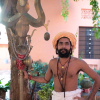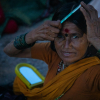Bengaluru has been a cultural melting pot since its inception, and the city stands testimony to numerous ritual centres and festivals which emerged from the various histories and communities. The Karaga festival is one of the oldest annual civic festivals celebrated in the historic Bengaluru Pete (old town) and its surrounding areas by Vahnikula Kshatriyas, a subgroup of the Tigala community which comprised gardeners, horticulturists and lake settlers said to have resided in the pete area during Kempe Gowda I’s rule (1537 AD) for better economic opportunities. Considered an important cultural and sacred event of the urban landscape of Bengaluru, the fiesta brings together the multireligious populace of the city.
Like any other festival in India, the 11-day Karaga festival is also steeped in mythology and is closely associated with the epic of Mahabharata. According to popular belief, Draupadi had to fight the demon Timarasura alone when she was on the way to heaven as her husbands and Krishna had already reached the other world ahead of her. An angered Draupadi took her Primordial Goddess form, known as Adi Shakti, and procreated warriors and weapons from different parts of her body. Together, the warrior sons and Draupadi fought the demon and slaughtered him. As Draupadi took leave of her sons, believed to be the ancestors of the Tigala community, she promised to visit them once a year. Karaga festival essentially celebrates the annual visit of the Goddess.
The celebration is intrinsically connected with the worship of nature and water as in Gange puje (Ganga worship) and is marked by rituals at various historic tanks of the city. The old city founded by Kempe Gowda I was a fortified town with rampart walls, gates, moats, and tanks and owing to the large number of water bodies, Bengaluru was once called Kalyanapuri (city of lakes/tanks). Karaga festival celebrates this unique geography of the city, offering prayers to the Goddess for good weather, especially rain, and peace in the city, and marks the advent of spring on a full moon day.
The word karaga means water pot in Kannada. On the commencing day of the festival, the priest carries a water pot in his left hand as he performs the rituals, hence Karaga is the name of the festival. The pot is considered sacred and symbolises the power of the Primal Goddess.
Special traditions and rituals are performed on each of the 11 days in a defined order. These rites are performed by different members of the Vahnikula Kshatriyas, holding different capacities, namely, kula gowda (community headman), ganachari (community chieftain and spiritual instructor of the Karaga priest), gante pujari (bell priest), Karaga pujari (priest who carries the karaga on his head), kula purohita (community priest), Potharaja pujari (priest from the household of a local king of the region, Potharaja), veerakumaras (heroic sons of Draupadi who protect the Karaga priest during the procession), bankadasi (musicians who play banka, a bugle-like instrument), kolkar (bearer of the news of ritual events), and chakridaras (festival workers).
The head priest for a particular year’s Karaga festival is selected during the previous year’s Dasara festival. Being married is one of the prerequisites to be chosen as the priest, who then undergoes a strict dietary and exercise regime at the garadi mane (ancient gymnasium) till the festival begins. Every day, throughout the festival, the priest immerses himself in the holy water of temples and tanks at nine points in the city as a part of cleansing it before the arrival of the Goddess.
Dharmaraya Swamy temple in Tigalara pete is the chief venue for the Karaga festivities, the commencing of which is marked by the dwajarohana (flag hoisting) on the saptami (seventh) day of the Chaitra (March/April) month. It is believed that from the first day of the festival, one can witness a gradual emergence of the Primal Goddess and on the hasi karaga (sacred pot) day, the Goddess is finally born in the form of the karaga made from hasi (unbaked) clay. The hasi karaga on triyodashi (thirteenth day of the month) and pete karaga (night procession) on purnima (full moon day—fifteenth day of the month) are the most significant rituals of the festival. During the night procession, apart from visiting temples within the pete area and the houses of priests, the karaga procession stops at the Hazrat Tawakkal Mastan Dargah in Cottonpet; this stop, performed in continuation of an ancient legend, is an exceptional feature of Karaga festival, highlighting its secular nature.
The other important traditions observed at the Karaga festival includes the aarati deepotsava (festival of lights) celebrated on dvadashi (twelfth day of the month) where women and girls of the Tigala community play the primary role, and the pongal seve (offering of sweet rice) observed on chaturdashi (fourteenth day of the month).
Karaga Purana or Vahni Purana (an oral epic associated with the Karaga performance) is recited on padyami (the day after full moon day) at Ellusutina Kote temple (seven-circled fort) within the campus of the city corporation building. After the Karaga procession is completed, Draupadi is married to Arjuna in a symbolic wedding: the Karaga priest decked in wedding finery enters the sanctum of Dharmaraya Swamy temple and conducts the ceremony in secrecy and later, the idols of Arjuna and Draupadi are placed next to each other in a chariot and taken on a procession through the streets.
The last day of the festival is synonymous with the joyous welcoming of the spring when the men playfully try to break coconuts filled in a gunny bag hung at a height while turmeric water is splashed at them. The flag raised in the beginning of Karaga festival is lowered at midnight of the last day; the end of the year’s festivities is marked by the immersion of the karaga in Cauvery River.
This photoessay is a pictorial representation of Karaga festival through its participants, the sacred locations where the various rituals are conducted, the decorations and the traditional events, and highlights the significance of such ancient festivals even in a fast-growing metropolitan city like Bengaluru.

















